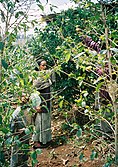Agriculture in Ethiopia is the foundation of the country's economy, accounting for half of gross domestic product (GDP), 83.9% of exports, and 80% of total employment.
Ethiopia's agriculture is plagued by periodic drought, soil degradation caused by overgrazing, deforestation, high population density, high levels of taxation and poor infrastructure (making it difficult and expensive to get goods to market). Yet agriculture is the country's most promising resource. A potential exists for self-sufficiency in grains and for export development in livestock, grains, vegetables, and fruits. As many as 4.6 million people need food assistance annually.
Agriculture accounts for 46.3% of the GDP, 83.9% of exports, and 80% of the labour force. Many other economic activities depend on agriculture, including marketing, processing, and export of agricultural products. Production is overwhelmingly of a subsistence nature, and a large part of commodity exports are provided by the small agricultural cash-crop sector. Principal crops include coffee, pulses (e.g., beans), oilseeds, cereals, potatoes, sugarcane, and vegetables. Exports are almost entirely agricultural commodities, and coffee is the largest foreign exchange earner. Ethiopia is Africa's second biggest maize producer. Ethiopia's livestock population is believed to be the largest in Africa, and in 2006/2007 livestock accounted for 10.6% of Ethiopia's export income, with leather and leather products making up 7.5% and live animals 3.1%.
Ethiopi's major staple crops include a variety of cereals, pulses, oilseeds, and coffee. Grains are the most important field crops and the chief element in the diet of most Ethiopians. The principal grains are teff, wheat, barley, corn, sorghum, and millet. The first three are primarily cool-weather crops cultivated at altitudes generally above 1,500 meters. Teff, indigenous to Ethiopia, furnishes the flour for enjera, an sourdough pancakelike bread that is the principal form in which grain is consumed in the highlands and in urban centers throughout the country. Barley is grown mostly between 2,000 and 3,500 meters. A major subsistence crop, barley is used as food and in the production of tella, a locally produced beer.
Sorghum, millet, and corn are cultivated mostly in warmer areas at lower altitudes along the country's western, southwestern, and eastern peripheries. Sorghum and millet, which are drought resistant, grow well at low elevations where rainfall is less reliable. Corn is grown chiefly between elevations of 1,500 and 2,200 meters and requires large amounts of rainfall to ensure good harvests. These three grains constitute the staple foods of a good part of the population and are major items in the diet of the nomads.
Pulses are the second most important element in the national diet and a principal protein source. They are boiled, roasted, or included in a stew-like dish known as wot, which is sometimes a main dish and sometimes a supplementary food. Pulses, grown widely at all altitudes from sea level to about 3,000 meters, are more prevalent in the northern and central highlands. Pulses were a particularly important export item before the revolution. (Full article...)
